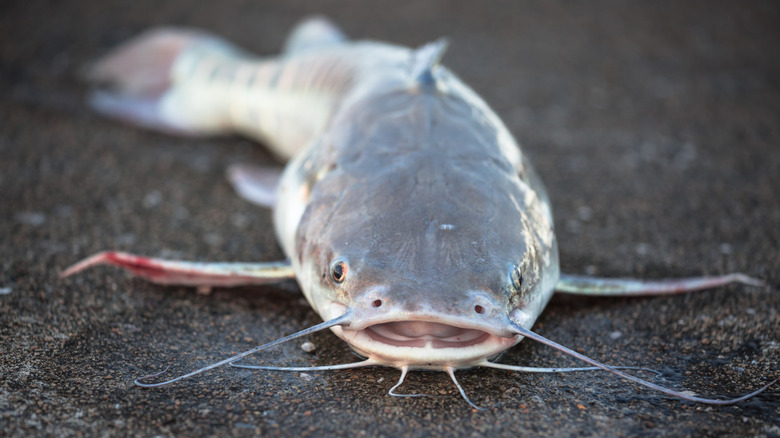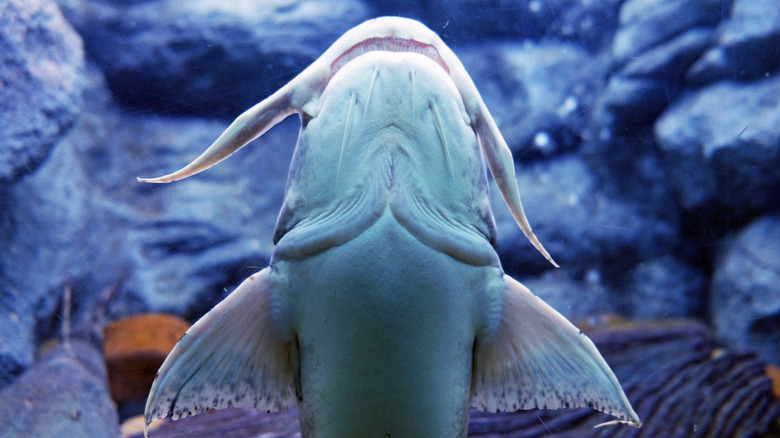Scientists Just Discovered A New River Species And The Predator Weighs Up To 220 Pounds
As many as 80% of the species living on Earth are still unidentified, according to a report from the World Economic Forum, but every year, researchers across the globe gradually chip away at this number. More than 10,000 species are identified every year on average, some from the unseen depths of the ocean and others that have been right under our noses for longer than anyone can know. Last year's animal discoveries have opened the doors to a wealth of new research, but 2025 is already bringing plenty more species to light, and one of them is so big, it'll make you wonder how it wasn't identified much earlier.
In a study published in the journal Zoosystematics and Evolution on June 24 of this year, researchers announced the discovery of two previously unidentified species of catfish in Southeast Asia. They belong to a genus of large, predatory bottom-feeders called Bagarius, and the two newly-identified species have been named Bagarius protos and B. dolichonema.
B. protos was discovered in the Salween River Basin in southern China while B. dolichonema was found not far away in the Irrawaddy River Basin in Myanmar. Researchers spent two decades collecting samples of these species and determined that the average B. protos is roughly a foot long and the average B. dolichonema roughly 8.5 inches long. But these creatures may be able to exceed those sizes, according to locals, who actually knew about these fish long before the recent study.
Locals knew of these fish before scientists identified them
What does it really mean to discover a species? The Bagarius genus of catfish has existed since at least the Pliocene epoch, which began 5.3 million years ago and ended 2.6 million years ago, so it's hardly realistic to think that the recent finds in China and Myanmar are "new" species. Rather than saying these researchers are the first to "discover" B. protos and B. dolichonema, it's more accurate to say they are the first to identify them as unique species and grant them a scientific name. This act formally inducts a species into the realm of science, but it doesn't mean that humans never encountered them before. Far from it.
In the case of B. protos, locals in the Salween River Basin had many encounters with the species before the research team that "discovered" it even arrived on the scene. The research team learned that the big catfish had historically been fished for food using thick nylon ropes baited with insect larvae. According to local accounts, B. protos can grow well beyond the sizes recorded by the research team. In fact, some say the creatures can reach 100 kilograms, or 220 pounds in weight, making them a highly valued catch.
Bagarius catfish can grow so big, they even threaten humans
Scientists have yet to confirm any specimens of B. protos that reach the massive weight described by local fishers, but there is a definite precedent to support the idea that this species could top 200 pounds. The near-mythical sounding size draws parallels to another member of the Bagarius genus that can grow so big, it has even been suspected of killing humans. It's known as the goonch, or the giant devil catfish. Long classified as the species B. yarrelli, scientists now believe that goonch actually belong to the species B. bagarius. This goes to show that, even when new species are identified, their status can change over time. Goonch can reach 6 feet in length and weigh as much as 250 pounds, similar to the rumored mass of B. protos.
Goonch became globally infamous in late 2000s, when the species was blamed for a series of deadly attacks in the Kali River along the border between India and Nepal, in which people were pulled underwater by a massive fish. The fish became the centerpiece of an episode of the Animal Planet series, "River Monsters". Fortunately, there are no such rumors of B. protos dining on human flesh. It seems to be perfectly happy with the natural diet of a catfish. However, the notoriety of the goonch lends credence to the idea that some members of this particular catfish genus can grow far beyond the average size of their species.


